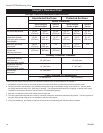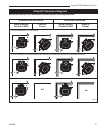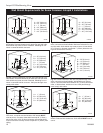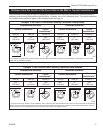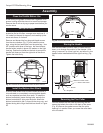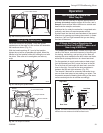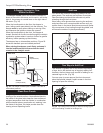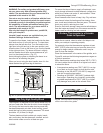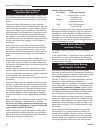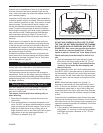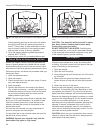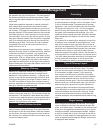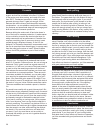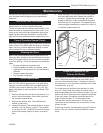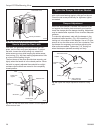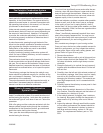
22
Intrepid II Woodburning Stove
2000966
Use the Air Control Settings
that Work Best for You
No single air control setting will fit every situation. Set-
tings will differ depending on the quality of the fuel, the
amount of heat desired, and how long you wish the fire
to burn.
The control setting also depends on your particular
installation’s “draft,” or the force that moves air from the
stove up through the chimney. Draft is affected by such
things as the length, type, and location of the chimney,
local geography, nearby obstructions, and other factors.
Too much draft may cause excessive temperatures in
the Intrepid II, and could even damage the combustor.
On the other hand, too little draft can cause backpuffing
into the room and/or the “plugging” of the chimney or
combustor.
How do you know if your draft is excessively high or
low? Symptoms of too much draft include an uncontrol-
lable burn or a glowing-red stove part. A sign of inad-
equate draft is smoke leaking into the room through the
stove or chimney connector joints, low heat, and dirty
glass.
In some newer homes that are well-insulated and
weather-tight, poor draft may result from insufficient air
in the house. In such instances, an open window near
the stove on the windward side of the house will provide
the fresh air needed.
Another option for getting more combustion air to the
stove is to duct air directly from outdoors to the stove.
In fact, in some areas provisions for outside combustion
air are required in all new construction.
Your Intrepid II will accept a duct carrying outside air for
combustion.
When first using the stove, keep track of the air control
settings. You will quickly find that a specific setting will
give you a fixed amount of heat. It may take some time
to determine the amount of heat and the length of burn
you should expect from various settings. Please read
the Draft Management section beginning on Page 25
for more information on how installation features affect
draft.
Most installations do not require a large amount of com-
bustion air, especially if adequate draft is available.
Do not for any reason attempt to increase the firing
of your heater by altering the air control adjustment
range outlined in these directions.
Use the following air control settings as a starting point
to help determine the best settings for your installation.
Each is described as a fraction of the total distance the
lever may be moved from right to left.
Intrepid II Control Settings
Burn Rate Primary Air Control
Low From far right to 1/3 the
distance to left
Medium From 1/3 to 2/3
the distance to left
High From 2/3 the distance
to left to far left
Before you start using the stove, please read the Draft
Management section starting on Page 25 to see how
the features of your installation will affect the stove’s
performance. You and the stove are parts of a system,
and other parts of the system have a strong effect on
operation; you may need to vary your firing technique to
get the performance you want.
How to Build a Wood Fire
and Keep it Going
An Intrepid II leaves the factory with the combustor
installed.
In the United States, it is against the law to operate this
wood heater in a manner inconsistent with operating
instructions in this manual, or if the catalytic combustor
is deactivated or removed.
High-Efficiency Wood Burning
with Catalytic Combustion
The catalytic combustion system in your Intrepid II
produces the best conditions for secondary combustion.
When the stove damper is closed, smoke goes through
the catalytic element, burning at temperatures of
500-600°F (260-315°C), half the temperature normally
needed for unaided secondary combustion.
The catalytic element is a ceramic “honeycomb” coated
with a noble metal, usually platinum. The element is in
the secondary combustion chamber, made of a spe-
cial high-temperature insulating refractory material.
The chamber provides the correct environment neces-
sary for secondary combustion of the fuel (smoke).
Closing the damper may also reduce draft. Closing the
damper too soon may put out the fire or deactivate the
combustor. Close the damper only when the fire is well
established. When starting a fire, wait until there is an
ember bed of at least 3-4” (76-102mm) before closing
the damper.
Never kindle a fire with colored paper or paper that
has colored ink or a glossy surface, and never burn
treated wood, garbage, solvents, or trash. All of these
may poison the catalyst and prevent it from operating
properly. Never burn cardboard or loose paper except
for kindling purposes. Never burn coal; doing so can



